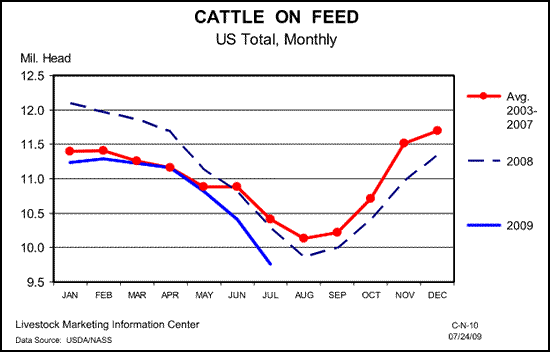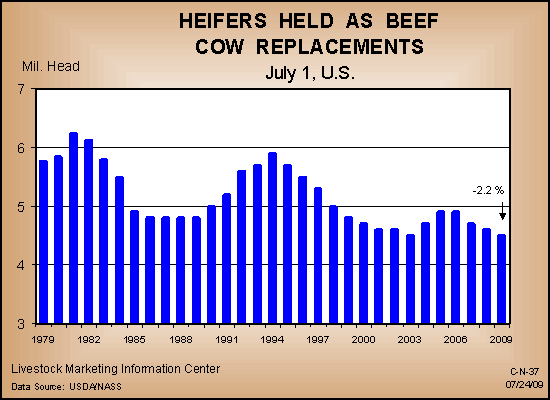MARKETING...
Cattle on Feed – 7/24/09

Cattle and calves on feed for harvest in the United States for feedlots with a capacity of 1,000 or more head totaled 9.8 million head July 1, 2009. The inventory was 5% below July 1, 2008, figures.
Placements in feedlots during June totaled 1.39 million, 8% below 2008. Net placements were 1.33 million head. This is the second-lowest placements level for the month of June since the series began in 1996.
Marketings of fed cattle during June totaled 1.99 million, 1% above 2008. This is the second-lowest fed-cattle marketings level for the month of June since the series began in 1996. Other disappearance totaled 57,000 during June, 5% below 2008 figures.
In the Cattle Markets
Feeder-cattle market seasonality
Feeder-cattle futures prices through 2009 have been trading in a very tight window relative to previous years. In the past few weeks the range of contract prices has tightened even more. On July 24, the range of feeder-cattle futures closing prices during the next 12 months was only 85¢. Although this date was the most dramatic, the trend has been the same all summer and continues to be that way today. This implies that the market has placed a premium on the November 2009 through May 2010 contracts when compared to their seasonal average price. This price range began to tighten drastically at the same time that corn prices were in a free fall and, thus, the likely culprit for this premium on deferred contracts. Furthermore, we continue to see less cattle being placed on feed, which gives further incentive for higher prices in the coming months. Read more.
Cattle Inventory Down From a Year Ago
U.S. Department of Agriculture National Agricultural Statistics Service (USDA-NASS) recently reported that the midyear U.S. cattle and calf inventory posted another year-to-year decline as of July 1, 2009. The report confirmed views that cow-calf producers during the last year have reduced their herds due to a variety of factors, including increases in production costs, lower calf prices and, in some regions, weather conditions.
Looking ahead, tighter supplies of available cattle will be supportive of fed-cattle prices. However, the demand for cattle and beef remains sluggish as the economic slowdown has put a damper on domestic and export beef demand, thus cattle prices will depend greatly on how well consumer demand recovers during the next year.
USDA reported the U.S. cattle herd at 101.8 million head vs. 103.3 million head last year and more than 2% below the 2007 midyear number. The number of beef cows at 32.2 million head and the number of dairy cows at 9.2 million head was expected.
USDA made notable downward revisions to last year's beef cow inventory and raised the number of dairy cows. According to the report, the number of beef heifers held as replacements was down a little more than 2%; at 4.5 million head, by historical standards the number of replacement beef heifers implies some further cow herd reductions are ahead.
Further, additional declines may occur in drought-stressed areas, including Texas, as the year progresses. USDA estimated the calf crop at 35.6 million head, about 500,000 head less than last year and the smallest since 1950.
Similar to last year, higher feedgrain costs have resulted in a number of calves placed out on pasture before being placed on feed. But, nationwide, smaller calf crops have compensated for longer grazing periods. Thus, as of July 1, the calculated number of feeder cattle outside of feedlots was around 38 million head, down about 200,000 head from last year.

If They Buy Cars, They Will Buy Beef
The "Cash for Clunkers" program added large incentives to buy new cars, and the willingness of consumers to pay for big-ticket purchases probably means the bite of the recession is beginning to ease.
"Consumers are beginning to feel a little better about their household budgets. If they will buy more cars, then surely they will also be willing to buy more beef," Chris Hurt, Purdue University economist, said.
The recession has cut deeply into cattle producer finances as loss of beef demand has ravaged cattle prices. "So far this year, beef production has been down 3%, but finished cattle prices have been down by 10%," Hurt said.
Nebraska finished steers have averaged just $82.70 per hundredweight (cwt.) so far this year compared with $92.30 for the same period in 2008. That is nearly $10 per cwt. lower prices with a smaller supply. Calf prices have been about $9 per cwt. lower this year compared to last. Unfortunately, retailers have been slow to reflect these much lower farm-level prices to consumers. Read more.

Sara Snider
The Source
AngusSource® grows, expands
opportunities with Gateway.®
In an effort to open the doors to value for more producers, the Gateway program was introduced at the end of July. Gateway is operated as an extension of the existing AngusSource Process Verified Program (PVP) and offers source and age verification with no genetic requirements. Gateway is run by the AngusSource department and follows the same policies, procedures, enrollment protocol and record requirements as the original AngusSource program — minus genetic requirements. Read more.
Tax Deferrals Possible When Selling
Livestock Due to Adverse Weather
Drought, floods and other weather-related problems are all too common in agriculture.
If you must sell livestock due to adverse weather conditions, you may be able to defer taxes on the sales, but always consult with your tax advisor to evaluate your individual situation.
If you sell or exchange more livestock in a given year (including poultry) than you normally would because of a drought, flood or other weather-related condition, you may be able to postpone reporting the gain from the additional animal sales until the following year.
All of the following conditions must be met in order to qualify:
• Your principal trade or business is farming.
• You use the cash method of accounting.
• You can show that, under your usual business practices, you would not have sold or exchanged the additional animals this year except for the weather-related condition.
• The weather-related condition caused an area to be designated as eligible for assistance by the Federal government (Declared Federal Disaster Area).
Deferring livestock sales of animals not raised for breeding stock will only defer the sale into the following tax period (tax year). If your farming operation meets the above criteria, recognized gain resulting from sales of breeding livestock may also be postponed.
Sales or exchanges made before an area became eligible for federal assistance qualify if the weather-related condition that caused the sale or exchange also caused the area to be designated as eligible for federal assistance. This designation can be made by the President, the U.S. Department of Agriculture (USDA), or by other federal departments or agencies.
Remember that the rules for deferral or postponing income due to disaster declaration are complicated. Always consult with your tax advisor to evaluate your options.
For more information on deferral of livestock income, view the 2008 Farmer's Tax Guide (Publication 225) at www.irs.gov/pub/irs-pdf/p225.pdf.

Steve Suther
CAB Corner
Power Cards
If you make a living on a ranch, that's a success. Just living on a ranch is a success. Heck, just taking one more breath can be a victory.
Everybody is a winner, at least in some small way. Success does not always manifest itself with visual clues, but you often see the trappings of new equipment, well-cared-for property and cattle that could win a stock show. Perhaps they did win.
Those things mean success in at least a material way, and they imply things are going well.
It's a very broad term, though. Everyone has personal definitions that may change over time, yet you can always succeed in helping each other where there is common ground. Read more.
USDA Market News
Click here for Livestock Cattle Reports, including Slaughter and Feeder and Replacement Cattle Reports.
Resources for Niche Markets
Click here to learn more about producing natural and organic beef
and/or grass-fed beef.
To view the Angus Almanac, a complete list of
Angus sales, click here.





